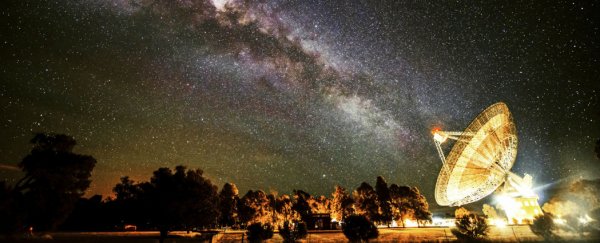Astronomers manning the Parkes radio telescope in New South Wales have detected the first real-time burst of radio waves from outside our Milky Way galaxy. Unlike similar cosmic events, such as gamma ray bursts or supernovae, which emit energy across several wavelengths, all the energy given off by blitzars is contained within the single band of the radio light spectrum.
The source of these 'blitzars' has so far remained a mystery, but finds like this could help scientists figure out what's causing them.
Blitzars were first discovered by researchers at Swinburne University of Technology in Melbourne using the Parkes telescope. Also known as ' fast radio bursts' ( FRB's), seven more were discovered - six more using the Parkes telescope, and one using Arecibo telescope in Puerto Rico - but each of these were found up to several years, after the actual event. That's what makes this latest discovery so special - the Swinburne researchers were able to detect the blitzar as soon as the resulting radiation reached Earth.
"These bursts were generally discovered weeks, months or even more than a decade after they happened," PhD student Emily Petroff, who witnessed the event, said in a university press release. "We are the first to catch one in real time."
Petroff has gotten to know these bursts of radio waves so well, that once she was confident she'd see a 'live' one, she let astronomers around the world know so they could make follow-up observations as soon as it was detected. So the aftermath was watched by scientists manning 12 telescopes in Australia, California, the Canary Islands, Chile, Germany, Hawaii, and India, plus the Swift Gamma Ray Burst Explorer in space, who captured it at wavelengths ranging from radio to X-ray.
Michael Slezek reports at New Scientist that the fact that, several hours after the explosion, no one saw an afterglow, makes it less likely that long gamma-ray bursts or supernovae were the source.
"Nobody knows what to make of it," astronomer Keith Bannister from Australia's national science agency, the CSIRO, told Slezek. "All the ideas are very exotic so ruling them out is all you can do at the moment."
"We can rule out some ideas because no counterparts were seen in the optical, infrared, ultraviolet or X-ray," Head of Astrophysics at CSIRO, Simon Johnston, added in the press release. "However, the neat idea that we are seeing a neutron star imploding into a black hole remains a possibility."
So the team is thinking that perhaps an oversized neutron star - which has the strongest magnetic field of anything in the known universe - collapsed. Normally, this would see it be consumed by a black hole, but perhaps it was spinning so fast, says Slezek, that relativity made it appear light enough to avoid that particular fate. "Other possibilities include a flare from a magnetar, a type of neutron star with an extremely strong magnetic field," he says.
Publishing their findings in The Monthly Proceedings of the Royal Astronomical Society, the team says they've calculated the blitzar to be up to 5.5 billion light-years away from Earth. "This means it could have given off as much energy in a few milliseconds as the Sun does in a day," she said in the press release.
Now that they've managed it once, Petroff thinks it's only a matter of time before they detect another 'real time' blitzar. "We've set the trap. Now we just have to wait for another burst to fall into it."
Want to explore space? Find out more about studying at Swinburne University of Technology.
Sources: New Scientist, Swinburne University
